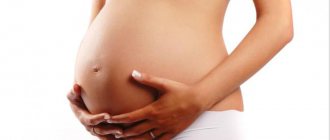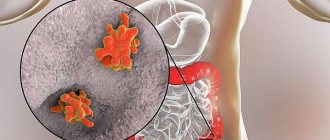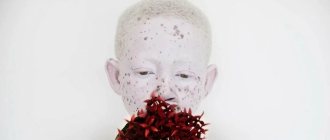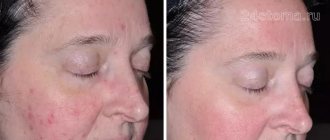Causes
The causative agent of the disease is a certain type of herpes virus, and signs of roseola in a child appear as a consequence of the body’s reaction to this virus. Symptoms and signs of roseola begin to appear only against the background of the presence of several factors.
In the practice of infectious disease doctors, there are cases when the cause of infection with the roseola virus in children occurs as a result of the baby’s contact with the carrier of the pathogen. In addition, roseola does not have a seasonal nature, but unfavorable weather conditions can increase the risk of developing the disease. Especially in the autumn-spring period, when there is a weakening of immunity in children, and the body is most susceptible to various types of infections. During this period, parents are advised to be especially attentive to the physical condition and well-being of their children.
In addition, the following factors can be identified among the causes of roseola in children:
- uncontrolled use of medications, resulting in a decrease in the body’s defenses;
- consequences of the child’s previous chemotherapy sessions;
- presence of cancer and HIV;
- impaired immunity as a result of congenital pathologies.
Pathogens
As mentioned above, the causative agent of roseola symptoms in children is herpes type 6. Since children under one year of age do not have immunity to this disease, they are the ones most susceptible to the development of roseola.
It is important to know that the incubation period can last about two weeks, but with a timely diagnostic examination and timely treatment, symptoms can be completely eliminated within 7 days.
There is evidence that one of the factors in infection entering a child’s body is the airborne route.
Tests and diagnostics
- The diagnosis of roseola is supported by the age of the child (from 6 months to 2 years) and typical symptoms.
- A general blood test revealed neutrophilic leukocytosis , then leukopenia .
- Serological methods (immunofluorescence, enzyme immunoassay, immunoprecipitation). IgM or an increase in the dynamics of IgG are detected (increasing them by 4 times). Detection of IgM is possible from 4-7 days of illness, the titer is maximum at 2-3 weeks, and is not detected 2 months after the illness. Determination of IgM titer is used to diagnose acute infection. However, not all children with this infection have IgM antibodies. Almost all adults have IgG to HHV-6.
- Detection of viral DNA in blood and tissues using PCR. Qualitative and quantitative PCR detects the virus in blood, saliva, and cerebrospinal fluid. A single detection of viral DNA in the blood and saliva is not an accurate confirmation of the disease; more often it indicates a persistent infection that developed after the primary one. Therefore, a dynamic examination is necessary. Determining a high titer of the virus is a reliable diagnosis of a primary infection.
Symptoms
The development of roseola symptoms in children occurs in stages, and begins with an increase in body temperature. However, all attempts to reduce it using antipyretic drugs and medications do not give the desired result. After some time, the signs of roseola are complemented by inflammation of the respiratory organs and the appearance of a skin rash.
The period of fever in a child can be 3 days. It is interesting that temperatures reaching a critical level of up to 40 degrees can appear suddenly and disappear just as suddenly. The development of the disease worsens the child’s well-being, which is characterized by:
- decreased appetite;
- general weakness of the body;
- enlarged lymph nodes in the occipital region and back of the neck;
- increased pulsation of the fontanel;
- pale skin on the hands;
- the appearance of febrile seizures;
- trembling chin;
- tendency to loose stools;
- the appearance of rhinitis and redness of the throat;
- the appearance of spots on the soft palate or tongue;
- cold feet and hands, despite elevated body temperature;
- the appearance of a skin rash in the form of pink spots with a white border.
If the above symptoms appear, you should immediately call a doctor to avoid possible complications.
Signs of viral exanthema in children
The initial manifestation of the disease is a slight malaise, after which the main symptoms appear:
- high temperature for three days (38-39 degrees);
- lack of appetite;
- increased drowsiness;
- the appearance of rashes localized on the stomach, back and chest;
- enlarged ear and cervical lymph nodes;
- liver enlargement, convulsions (not always).
Important: a characteristic sign of viral exanthema in children is the absence of a rash on the legs and arms.
In the baby’s blood at the height of the disease, there is an increase in lymphocytes and a decreased number of leukocytes.
Classification
Roseola in children can occur in the absence or presence of certain symptoms, so the disease is divided into two types.
The danger of an asymptomatic infectious disease is that it is not possible to start treatment in a timely manner, and in addition, the child during this period is a carrier of roseola and can infect other children through contact with them in kindergarten or school.
In the second case, the intensity of roseola symptoms is influenced by a number of important points:
- individual characteristics of the baby’s body;
- associated factors;
- level of the body's defenses (immunity).
When roseola occurs in a simple form, the child’s temperature rises and characteristic rashes appear on the skin. It is noteworthy that after treatment there is no fear of relapse.
As for the flaky form, it is distinguished by a profuse rash in the form of pink spots and blisters that cover the child’s skin, but is not accompanied by itching and does not cause discomfort to the baby.
Signs of secondary syphilis: diagnosis
To get an accurate diagnosis, it is recommended to undergo an examination.
Laboratory tests help prescribe an effective treatment regimen.
Differentiated diagnostics helps to establish the presence of syphilis.
Tests can exclude diseases such as rubella, measles, and skin diseases.
Before undergoing testing, you should visit a doctor.
To test for stage 2 syphilis, you should contact a dermatovenerologist.
This specialist will conduct a complete visual inspection and palpation of the affected areas.
After this, he will give directions for laboratory testing.
To confirm the diagnosis, it is necessary to take a discharge from the elements of the rash.
The doctor does the scraping of the skin.
The material is sent to the laboratory for further study.
Additionally, you should have your urine and blood tested.
Blood is drawn from a vein.
This is done in the morning, preferably on an empty stomach.
The main research method is the anticardiolipin test.
Additionally, serological research methods are used (RIF, RPGA, RIBT).
In case of damage to other organs and systems, the attending physician will refer you to specialists for examination.
You may need to consult the following specialists:
- 1. Neurologist
- 2.Gastroenterologist
- 3.Ophthalmologist
- 4.Urologist
- 5.Otolaryngologist
Instrumental diagnostic methods include organ ultrasound and gastroscopy.
Ultrasound examinations will help determine the degree of dysfunction of internal organs.
Timely diagnosis will help avoid the development of complications.
When to see a doctor
Considering that roseola can manifest itself as a sharp rise in temperature even before the rash appears, it is necessary to “play ahead” and consult a pediatric infectious disease specialist. Also, treatment of roseola in children should be started immediately when a rash appears on the skin. You cannot take any independent measures. Go to the clinic’s website and make an appointment with a doctor at a convenient time, get advice on the diagnosis and treatment of the disease. Remember that amateur activities can be dangerous and have disastrous consequences!
List of sources
- Yuldashev M.A., Rikhsiev U.Sh., Moon A.V. Sudden exanthema in children of early childhood // Young scientist. - 2015. - No. 18. — P. 77-80.
- Ovsyannikov D.Yu. Differential diagnosis of infectious diseases in children. Children's infections. 2015; 14(1):49-54.
- Kuskova T.K., Belova E.G. The herpesvirus family at the present stage // Attending Physician. 2004. No. 5. P. 611.
- Nikolsky M.A. Sudden exanthema in children: analysis of clinical cases. Sat. scientific works dedicated to the 170th anniversary of the First Children's Hospital of Russia: Modern technologies for the diagnosis and treatment of children and adolescents. Issue 2. St. Petersburg, 2005: 90–91.
- Pediatric dermatology: Handbook. Under. edited by D.P. Krouchuk, A. J. Mancini. lane from English Ed. N.G. Short. M.: Practical Medicine, 2010: 608.
Prevention
Any disease is easier to prevent than to treat. Considering the causes of roseola in children, which were mentioned above, prevention of the disease lies in strengthening the child’s body’s immunity from the first days of his birth. If adults develop protective forces against the viruses that cause three-day fever, then a young child is easy prey for a dangerous infectious disease.
It is important to know that in isolated cases, roseola can lead to severe complications, which can be avoided with timely treatment of roseola in children and following the recommendations of the attending physician.
When a child reaches the age of 4 years, the risk of getting roseola practically disappears. As practice shows, long-term breastfeeding of a baby is a good way to prevent this infectious disease.
The set of preventive measures includes the implementation of the following recommendations:
- the child should walk in the fresh air every day for at least 2 hours;
- it is important to provide him with adequate nutrition;
- to eliminate the risk of an infectious disease, it is necessary to maintain personal hygiene, timely clean the premises, care for the child, etc.;
- to strengthen the immune system, it is necessary to provide the child with proper nutrition, accustom him to gentle hardening procedures, and saturate the body with vitamins;
- it is necessary to promptly treat all diseases, especially infectious ones;
- The child should have adequate sleep and physical activity during the day.
Considering that in the autumn-winter period there is a decrease in immunity, parents need to pay due attention to strengthening the immune system during this period.
The lack of seasonal vegetables can be compensated for by consuming special balanced mineral and vitamin complexes for children.
Diagnostics
With similar symptoms of roseola and rubella, roseola has characteristic differences: the persistence of a febrile state for 3 days and the appearance of a rash on the 4th day.
In addition, the spots that appear on the skin are not accompanied by itching or discomfort, and after they disappear, there are no scars or scars on the skin. The rashes on the baby’s body are first localized in one place, and then gradually spread over the neck and face.
Treatment of roseola in children begins after confirmation of the presence of the disease through diagnostics, including tests. In the modern laboratory of JSC “Medicine” (clinic of Academician Roitberg) in the Central Administrative District, a number of tests are carried out, which are taken by a sick child:
- general blood and urine analysis;
- PCR analysis;
- stool analysis for dysbacteriosis;
- serological studies.
The results obtained during the research allow the pediatric infectious disease specialist to draw appropriate conclusions, make a diagnosis and determine how to treat roseola in a child, taking into account the characteristics of the course of the disease and the health status of a particular small patient.
An individual approach, highly qualified doctor and the wide capabilities of our medical institution allow us to quickly and effectively deal with the elimination of symptoms of the disease.
At JSC “Medicine” (clinic of academician Roitberg), all studies are carried out using modern equipment. Test results are provided as quickly as possible, which greatly facilitates making a diagnosis and prescribing the correct treatment. You can find out on the website the entire list of services, as well as their costs.
What does a roseola rash look like in a child?
The rash of baby fever is very similar to the rash of rubella. Small, pale pink pimples do not itch or cause any discomfort. Localization of rashes is the child’s back, stomach and chest. The rash is not contagious to others and usually goes away within five days. Your doctor will tell you more about what a roseola rash looks like in a child during your consultation.
Please note that with pseudorubella the baby does not have a cough, runny nose or other symptoms characteristic of ARVI.
Additional symptoms:
- swelling and redness of the eyelids;
- enlargement of individual lymph nodes;
- slight swelling of the mucous membranes;
- increased drowsiness.
Increased body temperature with roseola disease lasts no more than three days, after which a period of profuse rashes begins. The rash is irregular in shape and light pink in color. When pressed, pimples become whitish. The islands of rashes do not merge with each other.
On our website Dobrobut.com you can make an appointment with a doctor who will tell you the difference between syphilitic roseola spots in adults and skin manifestations of pseudorubella. At the center you can undergo a full examination of the body and receive a transcript of the research results.
Treatment
Treatment of roseola in children is carried out on the basis of an integrated approach, the main stage of which is drug therapy. Some proven folk remedies can be prescribed as a useful and effective addition to the main course.
An important role in the recovery process is played by adherence to a certain regimen, which allows you to quickly cope with the disease.
Important! If the temperature rises to critical levels and unsuccessful attempts to normalize it, there is no need to delay time and immediately call an ambulance by phone +7 (495) 229-00-03 (24 hours a day).
Consequences and complications
- Cramps. One third of cases of seizures due to fever are caused by primary infection with type 6 virus. Febrile seizures occur in 15% of children with fever. They usually last 1-3 minutes and do not leave behind focal symptoms of central nervous system damage. With prolonged status epilepticus, certain areas of the brain may be damaged. Parents of a child prone to febrile seizures need to more carefully monitor the temperature and reduce it in a timely manner, without leading the child to an attack.
- Much less common complications include encephalitis , meningitis , hepatitis , myocarditis , pneumonia , and thrombocytopenic purpura .
- Roseola infantum is dangerous for people with severe immune system disease or a provoked immune condition. AIDS patients , cancer patients, HIV-infected patients who have undergone chemotherapy and radiation therapy , organ and bone marrow transplants. The body cannot adequately respond to infection with viruses and fight them. Such patients are at risk of complications such as encephalitis and meningoencephalitis. For this reason, they require hospitalization.
Features of roseola treatment
If your child has been diagnosed with roseola, make sure that the patient is in a well-ventilated area and drinks small amounts of water every 20 minutes. This will avoid dehydration.
If a child refuses to eat during a fever, there is no need to force him to eat. When the temperature subsides, the baby's menu should consist of easily digestible foods and dishes rich in vegetables and fruits.
Drug treatment for roseola involves taking medications that should only be prescribed by a doctor based on test results. Any amateur activity in the treatment of an infectious disease is excluded!
At the same time as taking medications, it is necessary to treat the skin using special ointments and creams that will help quickly remove rashes on the baby’s body.
After the main course of treatment, the child is prescribed rehabilitation therapy, including taking vitamins and immunostimulating agents to improve the protective functions of the child’s body, walks in the fresh air, and active games.
When choosing medications to treat roseola in a child, the doctor pays special attention to medications to eliminate fever or seizures in the baby.
For this purpose, antipyretic drugs are used that are appropriate for the age of the young patient. It is known that not all antibiotics can be used to treat roseola, so the selection of medications and their prescription should be handled exclusively by a doctor.
As for folk remedies, caution must be exercised. For example, you should refrain from using them to reduce temperature.
It is important to know that with the help of natural ingredients you can improve the general condition of the child, but they will not affect the causative agent of the disease in any way. Folk remedies are effective at the last stage of treatment of roseola in children. Of the most common and effective traditional medicine recipes, the following are recommended.
- Dried fruits compote. To prepare it, you need to pour boiling water over any types of dried fruits or a mixture of them and after leaving for 1 hour, you can give it to your baby in small portions to maintain water balance and quench thirst.
- Herbal decoctions of chamomile, calendula, St. John's wort, and rose hips increase the body's resistance to infections. You can prepare decoctions using a simple standard method.
- Medicinal tea with raspberry leaves, lemon, linden, and a small amount of currant juice for a speedy recovery after illness.
If you follow all the doctor’s prescriptions and recommendations, the symptoms of the disease will quickly subside, and your baby will be healthy, cheerful and joyful again!
Roseola or three-day fever
Shaposhnikov Alexey Evgenievich
Dermatologist
April 25, 2021
Since an indispensable symptom of roseola is a rash on the skin, parents often turn not only to a pediatrician, but also to a dermatologist.
Infantile roseola has many names: sudden exanthema, three-day fever, pseudorubella . In many cases, it is not diagnosed as a separate disease; when the temperature rises, a diagnosis of ARVI is made, and the rash is attributed to an allergy to medications taken during the illness.
What is baby roseola?
Infantile roseola is a viral disease, which is characterized by a sharp rise in temperature, and then, after it decreases, the appearance of a small pink rash that spreads throughout the body. In the first three days, before the rash appears, it is difficult to make a diagnosis, since apart from temperature there are no characteristic symptoms. It is the appearance of the rash that helps determine that it is roseola.
This infection is presumably transmitted by airborne droplets, the incubation period is 9-12 days. Laboratory confirmation of the diagnosis is not required and, as a rule, no tests are performed. Typically, children from 6 months to 3 years old are sick, mainly in the spring and autumn.
What pathogen causes this disease?
Most often, roseola is caused by human herpes virus type 6, less often type 7. Herpes virus 6 (HHV-6) is very common and at birth, babies have antibodies from their mother that protect it. Their levels decrease significantly by 4 months, and the child becomes susceptible to infection. After 2 years, the immune system can already quite successfully cope with the virus, preventing the development of an acute disease. But in the interval, children’s bodies are most vulnerable; the peak incidence occurs at 6-12 months.
There is no specific prevention of roseola; general measures that reduce the risk of the disease include regular ventilation of the rooms where the child is, limiting close bodily contact with adults (do not kiss a small child on the lips, nose, lick spoons and pacifiers, and so on) .
After an illness, strong immunity is developed ; cases of re-infection are quite rare, but sometimes occur. After 4 years, almost all children examined have antibodies to this virus.
Characteristic signs of the disease?
- A rise in temperature to 38°C-40°C without respiratory symptoms (runny nose, cough, sore throat) and rashes. An increase in temperature is the body's reaction to the presence of a virus in the blood. On average, the temperature lasts 3 days.
- A rash of small pale pink spots, mainly on the neck and torso, in smaller quantities on the face and limbs, 1-2 days after the cessation of fever. Often a pale rim can be seen around the elements of the rash.
- The rash does not itch and goes away on its own within a few days or weeks.
How is roseola different from rubella?
With rubella, the rash appears simultaneously with fever, is located mainly on the extremities, and differs slightly in appearance. Also, rubella is not characterized by such a sharp and high rise in temperature.
Are there any complications?
In the vast majority of cases, the body copes on its own and without consequences. High fever with sudden exanthema can cause febrile convulsions . As a rule, they are not dangerous, pass without consequences for the child and are not associated with damage to the nervous system or brain. But, if this happens for the first time, the child should be examined by a neurologist.
Sometimes there are accompanying symptoms in the form of inflammatory processes in the nasopharynx and enlarged lymph nodes. Extremely rarely, with the appropriate predisposition, neurological complications of the disease are possible: encephalitis, meningitis.
How to treat roseola?
The child should be examined by a pediatrician, since a high temperature can occur not only with roseola, but also with other infectious diseases that require treatment, for example, otitis media, urinary tract infections.
There is no specific treatment for the virus that causes roseola, so treatment is symptomatic: antipyretics at high temperatures to alleviate the child’s condition. While the temperature persists, it is important to ensure that the child consumes enough fluids. If a child refuses to eat, there is no need to force feed; as soon as the condition improves, the appetite will return.
When a rash appears, there is no need to lubricate it with anything or take antiallergic medications. The spots go away on their own, leaving no traces; slight peeling of the skin is possible, which also goes away without treatment. The child can be bathed during this period. After swimming, you may notice an increase in the brightness of the rash due to blood flow to the skin; this is a temporary phenomenon that does not worsen the course of the disease.
Antiviral treatment is carried out in severe cases of the disease, usually in children with reduced immunity. When treating patients with immunodeficiency, consultation with a pediatric infectious disease specialist is necessary.









